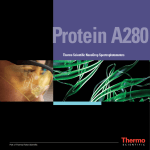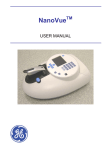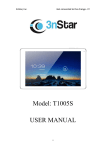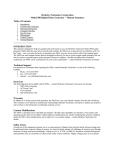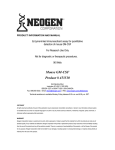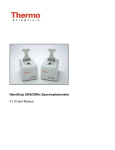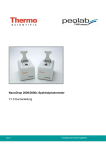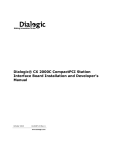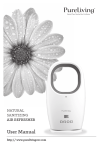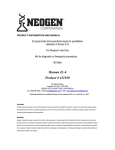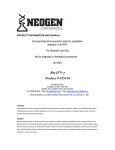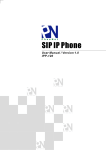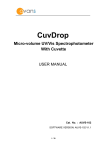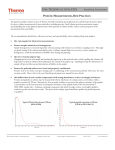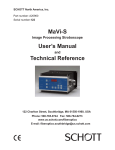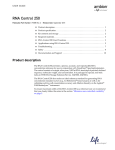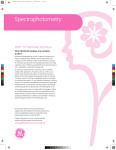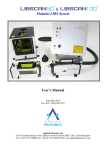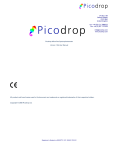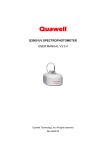Download Nucleic Acid - Thermo Scientific
Transcript
Nucleic Acid Thermo Scientific NanoDrop Spectrophotometers Part of Thermo Fisher Scientific Nucleic Acid The information in this publication is provided for reference only. All information contained in this publication is believed to be correct and complete. Thermo Fisher Scientific shall not be liable for errors contained herein nor for incidental or consequential damages in connection with the furnishing, performance or use of this material. All product specifications, as well as the information contained in this publication, are subject to change without notice. This publication may contain or reference information and products protected by copyrights or patents and does not convey any license under our patent rights, nor the rights of others. We do not assume any liability arising out of any infringements of patents or other rights of third parties. We make no warranty of any kind with regard to this material, including but not limited to the implied warranties of merchantability and fitness for a particular purpose. Customers are ultimately responsible for validation of their systems. © 2010 Thermo Fisher Scientific Inc. All rights reserved. All trademarks are the property of Thermo Fisher Scientific Inc. and its subsidiaries. Copyrights in and to the technical support image are owned by a third party and licensed for limited use only to Thermo Fisher Scientific by iStockphoto. No part of this publication may be stored in a retrieval system, transmitted, or reproduced in any way, including but not limited to photocopy, photograph, magnetic or other record, without our prior written permission. Microsoft, Windows, Windows NT and Excel are either trademarks or registered trademarks of Microsoft Corporation in the United States and/or other countries. Adobe and Acrobat are trademarks of Adobe Systems, Incorporated. All other trademarks are the property of Thermo Fisher Scientific Inc. and its subsidiaries. NanoDrop is a trademark of Thermo Fisher Scientific. Revised 11/2010 Thermo Scientific NanoDrop Spectrophotometers Nucleic Acid Contents Introduction Sample Retention Technology 4 5 Best Practices Cleaning & Reconditioning Instrument & Cuvette Orientation Sampling Technique Sample Purification 6 6 7 8 9 Measurements Blank Measurements Sample Measurements 10 10 10 Concentration Calculations Modified Beer-Lambert Equation Pathlength & Concentration 12 12 13 Purity Ratios 14 Calibration Calibration Verification Standard vs Control 15 15 16 Troubleshooting Purity Ratios Common Reagents Unusual Spectra Reproducibility Instrument Related Issues Installation Errors Connection Errors Signal Errors 17 17 18 19 20 21 22 23 23 FAQs 24 Technical Support 27 Thermo Scientific NanoDrop Spectrophotometers Introduction Nucleic Acid This booklet provides nucleic acid measurement support information relevant to Thermo Scientific NanoDrop 2000/2000c, 8000 and 1000 spectrophotometers. Please refer to the model-specific user manual for more detailed instrument and software feature-related information. The patented NanoDrop™ sample retention system employs surface tension to hold 0.5 μL to 2 μL samples in place between two optical fibers. Separate booklets for direct A280 protein measurement and colorimetric methods are also available. For technical support, please contact: Thermo Fisher Scientific | NanoDrop Products 3411 Silverside Road | Bancroft Building | Wilmington, DE 19810 USA Toll-free in US and Canada: 1.877.724.7690 Phone: 1.302.479.7707 | Fax: 1.302.792.7155 | e-mail: [email protected] www.nanodrop.com Thermo Scientific NanoDrop Instrument Serial Numbers: NanoDrop 1000: S/N_ ________, S/N_ ________ NanoDrop 2000: S/N_ ________, S/N_ ________ NanoDrop 2000c:S/N_ ________, S/N_ ________ NanoDrop 8000: S/N_ ________, S/N_ ________ 4 Thermo Scientific NanoDrop Spectrophotometers Nucleic Acid Introduction Introduction Sample Retention Technology •Pipette 1 – 2 μL sample directly onto the measurement pedestal. Tip: 0.5 μL aliquots may be used for samples that have 10 mm equivalent absorbance values of 3.0 or higher ( >150 ng/ μL dsDNA). NanoDrop 2000/2000c model only. •Lower the sampling arm and initiate a spectral measurement using the software on the PC. •Surface tension is used to hold samples in place between two optical fibers. •Light from a xenon flashlamp passes through the top optical fiber, down through the liquid column and is detected by the internal spectrometer. •When the measurement is complete, raise the sampling arm and wipe the sample from both the upper and lower pedestals using a dry, lint-free laboratory wipe. Using this technology, NanoDrop spectrophotometers have the capability to measure samples between 50 and 200 times more concentrated than samples measured using a standard 1 cm cuvette. 5 Thermo Scientific NanoDrop Spectrophotometers Best Practices Cleaning Nucleic Acid •An initial cleaning of both measurement surfaces with dH2O is recommended prior to making the blank measurement. Do NOT use a squirt or spray bottle to apply water or any other liquid to the surface of the instrument. •Between measurements: Wipe the sample from both the upper and lower pedestals with a clean, dry, lint-free lab wipe. •A final cleaning of both measurement surfaces with dH2O is recommended after the last sample measurement. Do NOT use a squirt or spray bottle to apply water or any other liquid to the surface of the instrument. •Additional cleaning: Use 3 µL of HCl instead of the dH2O for cleaning when samples have dried on the pedestal. Follow with a 3 µL aliquot of dH2O. •Detergents and isopropyl alcohol are NOT recommended cleaning agents as they may uncondition the pedestal measurement surfaces. If a solution containing detergents or alcohol is used, follow with 3 – 5 µL of dH2O. Reconditioning Use the NanoDrop Pedestal Reconditioning Compound (PR-1) as a rapid means of reconditioning the pedestals when the hydrophobic surface properties have been compromised and liquid columns break during measurement. 1. O pen the vial containing PR-1 and use the applicator provided in the kit to remove a pin-head sized amount of the compound. 2. Apply a very thin, even layer of PR-1 to the flat surface of the upper and lower pedestals. Wait 30 seconds for the PR-1 to dry. 3. F old a clean, dry laboratory wipe into quarters and remove the PR-1 by rubbing the surface of the upper and lower pedestals until no additional dark compound residue shows on the lab wipe. Pedestal Assessment To check the effectiveness of the reconditioning, pipet a 1 μL aliquot of dH2O onto the lower measurement pedestal and visually verify that the water “beads up.” Droplet “flattens out” on unconditioned pedestal 6 Droplet “beads up” on properly conditioned pedestal Thermo Scientific NanoDrop Spectrophotometers Best Practices Instrument Orientation Nucleic Acid Angle the instrument for optimal pipetting. Right-handed orientation for the NanoDrop 2000/2000c and close-up view of the NanoDrop 8000. Cuvette Orientation (NanoDrop 2000c only) Use etched arrow as light path guide when inserting quartz or masked plastic cuvette. Tip: Locate instrument away from air currents and exhaust fans. 7 Best Practices Below, recommended orientation for left- and right-handed sample dispensing on the NanoDrop 8000. Thermo Scientific NanoDrop Spectrophotometers Best Practices Volume Requirement Sampling Technique Nucleic Acid Use adequate sample volume to ensure good column formation. Tip: Although 1 μL volumes are usually sufficient for most sample measurements, increasing the sample size to 2 μL will ensure proper column formation for samples with reduced surface tension. Pipettor Selection Use calibrated pipettor with well-fitting tips. It is best to use a precision pipettor (0 – 2 μL) with low retention, precision tips to ensure that sufficient sample (1 – 2 μL) is delivered for optimal column formation. Tip: To avoid evaporation errors, it is essential to use an eight-channel pipettor to simultaneously load samples when using two or more pedestal positions on the NanoDrop 8000. Sample Aliquots Always use fresh tips and fresh aliquots for every measurement. Tip: Repeated measurements on the same sample aliquot will result in evaporation, yielding increasing concentrations and/or column breakage. Sample Homogeneity Highly concentrated nucleic acid samples require careful attention to ensure homogeneity before sampling. Tip: Non-reproducible results observed when making small volume measurements are a good indicator that the sample is not fully in solution or is not homogenous. Tip: It may be necessary to heat and/or lightly vortex samples prior to sampling to ensure homogeneity. Sample Preparation 8 Ensure sample isolation procedure is optimized and sample is purified prior to measurement. Thermo Scientific NanoDrop Spectrophotometers Nucleic Acid Any molecule that absorbs at 260 nm will contribute to the total absorbance value used to calculate sample concentrations. Examples include DNA, RNA, free nucleotides, proteins and some dyes, as well as many other molecules found in common buffers. Best Practices Sample Purification Tip: To minimize the potential of overestimating a nucleic acid sample concentration as a result of an interfering substance, it is important to purify samples prior to making absorbance measurements. Lab Notes 9 Thermo Scientific NanoDrop Spectrophotometers Measurements Blank Measurements Nucleic Acid 1. Perform the Cleaning and Reconditioning procedures outlined in the Best Practices section on page 6. 2. Open the Nucleic Acid application. Load an aliquot of the blanking buffer onto the lower measurement pedestal and lower the sampling arm. Tip: The blank solution should be the same pH and of a similar ionic strength as the sample solution. For nucleic acid samples, blank buffers are generally dH2O or TE. Blanking with water for samples dissolved in TE may result in low 260/230 ratios. 3. Click Blank to measure and store the reference spectrum. After the measurement is complete, use a dry, lint-free lab wipe to remove the buffer from both the top and bottom measurement surfaces. 4. Pipette a fresh aliquot of the buffer onto the pedestal, lower the arm and click Measure. The result should be a spectrum that varies no more than 0.04 Abs (10 mm absorbance equivalent) from the baseline at 260 nm. If not, clean the measurement surfaces and repeat steps 2 and 3. Tip: Although it is not necessary to blank between each sample, it is recommended that a new blank be taken every 30 minutes when measuring many samples. Sample Measurements 1. After the blank measurement is complete, enter the sample name in the Sample ID box, and choose the appropriate sample type as described below: Sample Type Select Option dsDNA ssDNA RNA Oligo DNA-50 DNA-33 RNA-40 Oligo DNA or Oligo RNA Custom Other Oligo Oligo *Range for user-entered constant. 10 Constant Used to Calculate Concentration 50 33 40 Oligo Calulator Defined 15 – 150* 15 – 150* Applicable Models All All All NanoDrop 2000/2000c and NanoDrop 8000 NanoDrop 2000/2000c NanoDrop 8000 and NanoDrop 1000 Thermo Scientific NanoDrop Spectrophotometers Sample Measurements 2. Pipette an aliquot of the nucleic acid sample onto the lower measurement pedestal and lower the sampling arm. Click Measure. Tip: If measuring more than one sample at a time on the NanoDrop 8000, it is important to use a multi-channel pipettor to deliver the sample aliquots. 3. After the measurement is complete, use a dry, lint-free lab wipe to remove the sample from both the top and bottom measurement surfaces. 4. Change pipette tips for the next measurement. Tip: If measuring multiple replicates of the same sample, it is important to use a fresh aliquot for every measurement to ensure accurate results. 5. Review spectral image to assess sample quality. 38 36 34 32 30 28 26 24 22 20 18 16 230nm 14 12 10 86420220 230 240 260nm 280nm 250 260 270 280 290 Wavelength nm Measurements 10 mm Absorbance Measurements Nucleic Acid 300 310 320 330 340 Typical Nucleic Acid Spectrum Refer to the Purity Ratios and Troubleshooting sections on pages 14 and 17 for more information. 11 Thermo Scientific NanoDrop Spectrophotometers Concentration Calculations Modified Beer-Lambert Equation Nucleic Acid c = (A * e)/b For nucleic acid quantification, a modification of the Beer-Lambert equation is used to calculate sample concentrations. •c is the nucleic acid concentration in ng/μL •A is the absorbance in AU • e is the wavelength-dependent extinction coefficient in ng-cm/μL •b is the pathlength in cm •The correction normalizes for any baseline offset attributable to light scattering artifacts. Nucleic acid sample concentrations are based on the absorbance at 260 nm, the selected analysis constant and a baseline correction. •The wavelength for the baseline normalization is 340 nm. The generally accepted extinction coefficients or constants for nucleic acids are as indicated to the right: •Double-stranded DNA: 50 ng-cm/μL Concentrations determined by absorbance measurements with NanoDrop spectrophotometers are reported in terms of mass units (i.e., ng/μL). 12 Tip: The user may manually enter a different wavelength to be used for the baseline normalization of nucleic acid samples when using the NanoDrop 2000/2000c. •Single-stranded DNA: 33 ng-cm/μL •RNA: 40 ng-cm/μL Tip: Unit conversion calculators are available on the internet for the conversion of concentrations from mass to molar units based upon the specific sequence of the sample. Thermo Scientific NanoDrop Spectrophotometers Concentration Calculations Pathlength & Concentration Nucleic Acid NanoDrop instrument pedestal measurements utilize pathlengths of 1.0 mm to 0.05 mm (model dependent). The pathlengths are the distance between the optical fibers embedded in the upper and lower measurement surfaces. As described in the previous section, the pathlength is one component of Beer’s Law and must be taken into account when calculating sample concentrations using absorbance measurements. As the pathlength gets shorter, the ability to measure higher concentrations without saturating the internal detector increases. Although the upper detection limit of the internal spectrometer is ~ 1.5 Absorbance units, the NanoDrop sample retention technology allows for the use of shorter pathlengths, thereby extending the absorbance range of the instrument. The graphic below illustrates how utilizing pathlengths less than the standard 10 mm cuvette pathlength enables higher concentrations of samples to be measured without making sample dilutions. 10 mm pathlength max concentration = 75 ng/µL dsDNA 1 mm pathlength max concentration = 750 ng/µL dsDNA 0.2 mm pathlength max concentration = 3,750 ng/µL dsDNA 10 mm pathlength max Abs value = 1.5 Equivalent to max Abs value of 15 when normalized to a 10 mm pathlength Equivalent to max Abs value of 75 when normalized to a 10 mm pathlength Detection Limits for dsDNA NanoDrop 2000 2 to 15,000 ng/μL NanoDrop 2000c 0.4* to 15,000 ng/μL NanoDrop 8000 2.5 to 3750 ng/μL NanoDrop 1000 2 to 3750 ng/μL Concentration Calculations Model * Denotes lower detection limit when using 10 mm path cuvette. 13 Thermo Scientific NanoDrop Spectrophotometers Purity Ratios Nucleic Acid Although purity ratios are important indicators of sample quality, the best indicator of DNA or RNA quality is functionality in the downstream application of interest (e.g., real-time PCR). 260/280 Ratio •A 260/280 ratio of ~ 1.8 is generally accepted as “pure” for DNA. •A 260/280 ratio of ~ 2.0 is generally accepted as “pure” for RNA. •The reported 260/280 ratio is dependent on the pH and ionic strength of the buffer used to make the blank measurement and sample measurements. Acidic solutions will under-represent the 260/280 ratio by 0.2 – 0.3, while a basic solution will over-represent the ratio by 0.2 – 0.3**. ** William W. Wilfinger, Karol Mackey, and Piotr Chomczynski, Effect of pH and Ionic Strength on the Spectrophotometric Assessment of Nucleic Acid Purity: BioTechniques 22:474-481 (March 1997) Tip: If the ratio is appreciably different than the accepted target described above, it may indicate the presence of protein, phenol or other contaminants that absorb strongly at or near 260 nm. Tip: It is important to ensure that the blank and sample buffers are at the same pH and ionic strength. 260/230 Ratio •The 260/230 values for a “pure” nucleic acid are often higher than the respective 260/280 values and are commonly in the range of 1.8 – 2.2. Tip: If the ratio is appreciably different than the accepted target, it may indicate the presence of residual phenol, guanidine, magnetic beads, carbohydrates or proteins. Tip: It is important to ensure that the blank and sample buffers are at the same pH and ionic strength. A low 260/230 ratio may indicate an issue with the buffer used for the blank measurement. Refer to the Troubleshooting section on page 17 for more information. 14 Thermo Scientific NanoDrop Spectrophotometers Calibration Verification All NanoDrop spectrophotometers include a diagnostic application which allows the user to run a Calibration Check procedure to confirm that the instrument is working within specifications. Wavelength Calibration (Automatic) • Wavelength calibrations using standard reference lines in the xenon flashlamp spectrum are automatically performed within the operating software. •Use CF-1 in conjunction with the Calibration Check diagnostic to verify that the pathlengths are within specification. •The pathlengths used to make measurements are the same across all wavelengths. Therefore, when pathlengths are verified at one wavelength, the verification is valid for the entire measured spectrum. Calibration Check Fluid •CF-1 is a standard manufactured exclusively for use with NanoDrop Spectrophotometers and is available from Thermo Fisher Scientific and its distributors. •The CF-8 Calibration Kit (used for the NanoDrop 8000 calibration check procedure) includes 2 CF-1 vials as well as 8-well PCR strip tubes. Tip: It is good practice to check the instrument’s performance every six months with a new vial of NanoDrop Calibration Check Fluid. 15 Calibration Verification •This verification ensures wavelength accuracy and does not require any action by the user. Pathlength Verification (User-performed) Purity Ratios Calibration Nucleic Acid Thermo Scientific NanoDrop Spectrophotometers Nucleic Acid Calibration Standard vs Control A “Standard” is generally accepted as a solution of a known concentration that is used to calibrate or certify that an instrument is working within acceptable, pre-defined guidelines. A “Control” is a solution that produces an expected result within a specific range if the “system” is working as expected. The definition of system would include the instrument, protocols being used, techniques employed by the user and the solution utilized as the control. •The NanoDrop CF-1 Calibration Check Fluid is the only acceptable standard for use with NanoDrop spectrophotometers. •In general, most DNA ladders (without added dyes) are appropriate for use as routine laboratory control solutions to monitor the reproducibility between replicates and monitor values obtained from day to day use. •Controls are valid to use as long as the instrument is calibrated and the control product itself is within the expected concentration range stated in the manufacturer’s specifications. Tip: Ensure all controls are stored as recommend by the manufacturer. Do not use controls past the stated expiration date. 16 Thermo Scientific NanoDrop Spectrophotometers Troubleshooting Nucleic Acid When troubleshooting sample measurements, it is important to utilize the sample spectrum as a primary guide. Wavelength Wavelength nm nm Typical nucleic acid sample spectrum 10 mm Absorbance 1.4 - 1.4 1.3 - 1.3 1.2 - 1.2C 1.1 - 1.1 1.0 - 1.0 0.9 - 0.9 0.8 - 0.8 0.7 - 0.7 0.6 - 0.6B 0.5 - 0.5 0.4 - 0.4 0.3 - 0.3A 0.2 - 0.2 0.1 - 0.1 0.0 - 0.0 - C A =ANormal = Normal B =BGuanidine = Guanidine C =CPhenol = Phenol B A 220 220 230 230 240 240 250 250 260 260 270 270 280 280 290 290 300 300 310 310 320 320 330 330 340 340 Wavelength Wavelength nm nm Comparison of nucleic acid sample spectra with and without 2 common contaminants Troubleshooting Purity Ratios 10 mm Absorbance 38 - 38 36 - 36 260nm 260nm 34 - 34 32 - 32 30 - 30 28 - 28 26 - 26 24 - 24 22 - 22 20 - 20 280nm 280nm 18 - 18 16 - 16 230nm 14 - 14 - 230nm 12 - 12 10 - 10 8- 86- 64- 42- 20- 0220 220 230 230 240 240 250 250 260 260 270 270 280 280 290 290 300 300 310 310 320 320 330 330 340 340 10 mm Absorbance 10 mm Absorbance A typical nucleic acid sample will have a very characteristic profile as shown in the figure below, left. In the figure below, right, the shifts in the peaks and troughs of samples B and C, compared to sample A, illustrate how contaminants can affect the spectra of nucleic acid samples. Although 260/280 or 260/230 ratios are commonly used indicators to assess sample quality, ratios may sometimes fall within the range typically associated with “pure” samples but wavelength shifts in the trough (from 230 nm to 235 nm) or the sample peak (from 260 nm to 270 nm) may identify the sample to be of poor quality. Listed below are three common sources of contaminants: •Phenol/Trizol extraction—residual reagent contamination may be indicated by abnormal spectra between 220 to 240 nm as well as by shifts in the 260 to 280 nm region. •Column extraction—residual guanidine may contribute to a peak near 230 nm and a shift in the trough from 230 nm to ~ 240 nm. •Magnetic Beads—residual beads may cause light scatter and result in abnormal spectra. •Samples with concentrations approaching the lower limit of 2 ng/uL may result in unacceptable 260/280 and/or 260/230 ratios. 17 Thermo Scientific NanoDrop Spectrophotometers 12.22 12.22- - 9.38 9.38- - 11.00 11.00-- -12.22 12.22 10.00 10.00- 11.00 11.00- 9.00 9.00- 10.00 10.00- 8.00 8.00- 9.00 9.00- 7.00 7.00- 8.00 8.00- 6.00 6.00- 7.00 7.00- 5.00 5.00- 6.00 6.00- 4.00 4.00- 5.00 5.00- 3.00 3.00- 4.00 4.00- 2.00 2.00- 3.00 3.00- 1.00 1.00- 2.00 2.00- 0.00 0.00- 1.00 1.00- 220 220 230 230 240 240 250 250 260 260 270 270 280 280 290 290 300 300 310 310 320 320 330 330 340 340 350 350 0.00 0.00- Wavelength Wavelengthnm nm 220 220 230 230 240 240 250 250 260 260 270 270 280 280 290 290 300 300 310 310 320 320 330 330 340 340 350 350 9.38 9.38-- -8.00 8.00 10mm 10mm Absorbance Absorbance 10mm 10mm Absorbance Absorbance Common Reagents Below are several examples of reagents commonly used with nucleic acids that have absorbance in the 220 – 240 nm range. Note: Phenol also exhibits significant absorbance between 260 – 270 nm which may shift the peak and result in an overestimation of the nucleic acid concentration. Wavelength Wavelengthnm nm 7.00 7.00 8.00 8.00- - 10mm 10mm Absorbance Absorbance 10mm 10mm Absorbance Absorbance Troubleshooting Nucleic Acid 6.00 6.00 7.00 7.00- 5.00 5.00 6.00 6.00- 4.00 4.00 5.00 5.00- 3.00 3.00 4.00 4.00- 2.00 2.00 3.00 3.00- 1.00 1.00 2.00 2.00- 0.00 0.00 1.00 1.00- 220 220 230 230 240 240 250 250 260 260 270 270 280 280 290 290 300 300 310 310 320 320 330 330 340 340 350 350 0.00 0.00- Wavelength Wavelengthnm nm 220 220 230 230 240 240 250 250 260 260 270 270 280 280 290 290 300 300 310 310 320 320 330 330 340 340 350 350 Wavelength Wavelengthnm nm Phenol EDTA 60 60- - 12 12- - 60 60- - 12 12- - 50 50- - 10 10- 10 10- - 40 40- - 10 10 mm 10 mm mm 10Absorbance Absorbance mm Absorbance Absorbance 10mm 10mm Absorbance Absorbance 10mm 10mm Absorbance Absorbance 50 50- 40 40- 30 30- 30 30- 20 20- 20 20- 10 10- 10 10- - 88- 88- 66- 66- 44- 44- 22- 22- - 00- - 220 220 230 230 240 240 250 250 260 260 270 270 280 280 290 290 300 300 310 310 320 320 330 330 340 340 350 350 00- 220 220 230 230 240 240 250 250 Wavelength Wavelength nm nm300 260 260 270 270 280 280 290 290 300 Wavelength Wavelengthnm nm 310 310 320 320 330 330 340 340 350 350 Guanidine Isothiocyanate 00- 220 220 230 230 240 240 250 250 260 260 270 270 280 280 290 290 300 300 310 310 320 320 330 330 340 340 350 350 00- Wavelength Wavelength nm nm 220 220 230 230 240 240 250 250 260 260 270 270 280 280 290 290 300 300 310 310 320 320 330 330 340 340 350 350 Wavelength Wavelengthnm nm Guanidine HCI Tip: For samples with ratios that fall outside the expected optimal values, it is suggested that the user refer to the manufacturer of the isolation kit for additional information regarding protocol optimization and troubleshooting. 18 Thermo Scientific NanoDrop Spectrophotometers Nucleic Acid Troubleshooting Unusual Spectra 2.0 - 10mm Absorbance 1.5 - Negative values associated with some spectra indicate that either the pedestals were very dirty when the blank measurement was made or that a sample was used to make a blank or reblank measurement. 0.5 0.0 -0.5 -1.0 -1.5 - Suggestion: -2.0 -2.5 -3.0 220 230 240 250 260 270 280 290 300 310 320 330 340 350 Clean pedestal and measure new blank. Wavelength (nm) 1.00 0.90 - 10mm Absorbance 0.80 0.70 0.60 - A ragged appearance throughout a spectrum may indicate a bad blank. 0.50 0.40 0.30 - Suggestion: 0.10 - Clean pedestal and measure new blank. 0.20 0.00 - -0.10 220 230 240 250 260 270 280 290 300 310 320 330 340 350 Wavelength (nm) 1.00 0.90 - 10mm Absorbance 0.80 0.60 - A jagged appearance throughout a spectrum may indicate a broken column. 0.40 - Suggestions: 0.70 0.50 0.30 0.20 0.10 0.00 - -0.10 220 230 240 250 260 270 280 290 300 310 320 330 340 350 Clean and recondition both measurement surfaces, then measure a new blank. Increase sample volume to ensure proper column formation. Wavelength (nm) A very high 230 nm absorbance value relative to the sample is indicative of contaminants such as carbohydrates, peptides, phenols, urea, humic acid or guanidine isothiocyanate in the sample. It may also be the result of using an improper solution when making the blank measurement. 1.00 0.90 - 10mm Absorbance 0.80 0.70 0.60 0.50 0.40 0.30 0.20 - Suggestions: 0.00 - Empirically determine if downstream applications are affected by samples that exhibit this type of profile. Contact isolation kit manufacturer for additional information about optimizing the isolation protocol. 0.10 -0.10 220 230 240 250 260 270 280 290 300 310 320 330 340 350 Wavelength (nm) 19 Thermo Scientific NanoDrop Spectrophotometers Nucleic Acid Troubleshooting Reproducibility Non-reproducible results are usually due to issues with sample non-homogeneity, blanking on a dirty pedestal, using the same aliquot for multiple measurements, or column breakage. Sample Heterogeneity •Sampling from non-homogeneous solutions, particularly when using small volumes, may result in significant measurement deviation in the generated data. •Ensure sample solution is homogeneous by heating and/or gentle vortexing, as appropriate. Dirty pedestal •Clean and recondition the pedestal surfaces prior to the start of the measurement session. •Follow the suggestions in the Blank Measurements section on page 10, prior to making sample measurements. Multiple Measurements •Use fresh aliquots for each pedestal measurement. Tip: Multiple measurements of the same aliquot may result in evaporation and increased sample concentration values. Column Breakage 20 •Visually check that a column is intact after the completion of the measurement. If not, refer to the Instrument Related Issues section for guidance. Thermo Scientific NanoDrop Spectrophotometers Nucleic Acid Troubleshooting Reproducibility Concentrations not within Expected Range •Ensure samples fall within the linear detection range of the instrument. Tip: Refer to the table of model-specific detection limits on page 13 for guidance. Instrument Related Issues •Ensure sample solution is homogeneous by gentle vortexing, as appropriate. •Confirm that the reference (blank) solution and sample solvent are the same material. •Clean and recondition the pedestal surfaces prior to the start of the measurement session. •Ensure appropriate sample type is selected as concentration calculations utilize constants specific to each sample type. Column Breakage •Ensure pedestal surfaces are properly conditioned. Tip: When a pedestal becomes unconditioned, sample droplets applied to the bottom pedestal will “flatten out” and cover the entire pedestal surface rather than “bead up.” Refer to the Reconditioning instructions under the Best Practices section on page 6. •Ensure sufficient volume is loaded onto the pedestal. •Use a larger volume (1.5 – 2 μL) for each measurement. •Use a calibrated small volume pipettor to deliver the sample to the pedestal. •Ensure instrument is not located near a vent or other source of air flow. •Ensure measurements are made immediately after pipetting samples onto the pedestal, as delays may compromise accuracy. •If an error message indicating possible column breakage is displayed and the user visually confirms that the liquid column is forming, perform a calibration check. If the instrument is out of calibration, contact Technical Support. Outside of the US and Canada, please contact your local NanoDrop products distributor. 21 Thermo Scientific NanoDrop Spectrophotometers Nucleic Acid Troubleshooting Installation Errors Usually, an installation failure is the result of an unsuccessful installation of the device drivers. •Verify system specifications meets published requirements. •Verify that user has full Administrator access to the software and data folders and that the use of USB devices is acceptable. •Verify that the instrument is receiving power. •Verify driver installation using the Device Manager: 1. Locate the My Computer icon on the desktop or access through the Windows Start menu. Right click on My Computer. 2.Highlight and select Manage. 3. Click on Device Manager in the left pane. 4. Locate the NanoDrop device folder from the list displayed in the right pane, and click on the + (plus sign) to open. Tip: Yellow exclamation points or question marks associated with either a NanoDrop or an unknown device indicate drivers did not install properly. 5.Highlight and delete the questionable device. 6. Unplug the USB cable from the computer and the power cord from the instrument. Wait 10 seconds, then reconnect beginning with the power cord. If the error persists, contact Technical Support. Outside of the US and Canada, please contact your local NanoDrop products distributor. 22 Thermo Scientific NanoDrop Spectrophotometers Nucleic Acid Troubleshooting Connection Errors instrument •Ensure that the USB and power cables are plugged into the back If your operates properly of the instrument, and that the instrument is receiving power. most of the time, but errors connection •Many instrument issues can be addressed by a simple power appear intermittently, restart. the instrument may 1.Exit the software. not be receiving power, or recognizing 2.Disconnect the instrument power cord and USB cable. the USB connection. 3.Reconnect the instrument power cord first, then the USB cable. 4.Restart the software. Signal Errors If the error persists, contact Technical Support. Outside of the US and Canada, please contact your local NanoDrop products distributor. Some error messages are triggered when little to no light reaches the detector during initialization or a measurement. •Refer to the cleaning directions under the Best Practices section on page 6. •Run the Intensity Check diagnostic. Refer to the model-specific user guide for additional information. 23 Thermo Scientific NanoDrop Spectrophotometers FAQs Nucleic Acid Q:Do nucleic acids require purification prior to measurement on NanoDrop spectrophotometers? A: Yes. As with any spectrophotometer, absorbance measurements are not specific for a particular nucleic acid and will be affected by the presence of nucleotides and other molecular contaminants which absorb at 260 nm. Q: What are the sample size requirements when using NanoDrop spectrophotometers? A: Although 1 μL volumes are usually sufficient for most pedestal-based sample measurements, increasing the sample size to 2 μL will ensure proper column formation for samples with reduced surface tension properties. Q: When is a 0.5 μL volume sufficient? A: The small sample volume option available in the Nucleic Acid application on the NanoDrop 2000/2000c model is for samples that have 10 mm equivalent absorbance values of 3.0 or higher (>150 ng/μL dsDNA). Q: What are the nucleic acid detection limits? A: The detection limits vary according to the NanoDrop model as shown below: Model Detection Limits for dsDNA NanoDrop 2000 2 to 15,000 ng/μL NanoDrop 2000c 0.4* to 15,000 ng/μL NanoDrop 8000 2.5 to 3750 ng/μL NanoDrop 1000 2 to 3750 ng/μL * Denotes lower detection limit when using 10 mm path cuvette. 24 Thermo Scientific NanoDrop Spectrophotometers FAQs Nucleic Acid Q: What if my samples are less concentrated than the above indicated lower detection limits? A: Fluorescent dyes can be used in conjunction with the NanoDrop 3300 Fluorospectrometer to detect dsDNA or RNA samples as low as 1 pg/μL. Please refer to the NanoDrop 3300 product page at www.nanodrop.com for more information. Q: Can I quantify other types of samples (i.e. proteins or microbial cell cultures) with NanoDrop spectrophotometers? A: Yes. The NanoDrop 2000/2000c, 8000 and 1000 can be used for protein A280 measurements, colorimetric assays, microbial cell cultures, as well as other UV/Vis measurements. Q: Can I quantify nucleic acids labeled with fluorescent dyes? A: Yes. The Microarray application enables the simultaneous measurement of both the absorbance of nucleic acid and the absorbance of the fluorescent dye, allowing detection at dye concentrations as low as 0.2 picomole per microliter. Q: Can I measure the emission of fluorescent dyes? A: No. The NanoDrop 3300 Fluorospectrometer is the appropriate model to detect the emission of fluorescent dyes often used with nucleic acid samples. Q: What sort of accuracy should I expect with NanoDrop spectrophotometers? A: Typically within 2% at the 1 mm pathlength. Q: What sort of reproducibility should I expect with NanoDrop spectrophotometers? A: Typically ± 2 ng/μL for samples < 100 ng/µL and ± 2% for samples > 100 ng/μL. Q: Is simply wiping the pedestal surface enough to prevent carryover? A: Yes. The highly polished quartz and stainless steel surfaces of the sample retention system are resistant to sample adherence, making the use of dry laboratory wipes very effective in removing the sample. A: Use the NanoDrop PR-1 Reconditioning Compound as a rapid means of reconditioning the pedestals when the surface properties have been compromised and liquid columns break during measurement. PR-1 kits are available through Thermo Fisher Scientific or your local distributor. 25 FAQs Q: How do I keep my sample from flattening out on the measurement pedestal? Thermo Scientific NanoDrop Spectrophotometers FAQs Nucleic Acid Q: What is the cause of negative absorbance values? A: A blank measurement was made on a dirty pedestal or using a solution with more absorbance than the sample of interest. Clean the pedestal and make a new blank measurement with a fresh aliquot of the appropriate buffer. Q: How do I check the accuracy of NanoDrop spectrophotometers? A: NanoDrop CF-1 Calibration Check Fluid should be used with the Calibration Check diagnostic in the instrument software. CF-1 is prepared from the NIST potassium dichromate standard SRM935 in acidified reagent grade water. Q: How do I calibrate NanoDrop spectrophotometers? A: The calibration check procedure allows the user to confirm that the instrument is performing within specifications. If the instrument requires recalibration, contact Technical Support. Outside of the US and Canada, please contact your local NanoDrop products distributor. Q: Where is the data stored? A: The NanoDrop 2000/2000c software allows the user to save a workbook (.twbk) at a location of the user’s preference for recording measurements. The default data storage location is in the My Documents folder. The NanoDrop 8000 and the NanoDrop 1000 models automatically archive all measurement data in a folder on the C drive. Refer to the model-specific user manual for additional details. A PDF version of each manual may be found at www.nanodrop.com. Q: Is the flash lamp continuously on, or is it on only when performing a measurement? A: The lamp is on only during measurements. Q: Are there solvent restrictions? A: Yes. Do not use hydrofluoric acid on the pedestal as it may etch the quartz optical fiber. Most other laboratory solvents typically used in life science labs, including dilute acids, are compatible with the pedestal as long as they are immediately wiped off upon the completion of the measurement. Tip: The use of volatile solvents for sample measurement may result in erroneous data due to the rapid evaporation of the 1 – 2 μL sample volume. 26 Thermo Scientific NanoDrop Spectrophotometers F or additional assistance, please contact us at 1.877.724.7690 or send an email to: [email protected]. The Thermo Scientific NanoDrop Product Technical Support Team is available between 9am and 5pm, EST. For technical support outside of the US and Canada, please contact your local Thermo Scientific NanoDrop products distributor. Additional technical information is available at: www.nanodrop.com. Thermo Fisher Scientific | NanoDrop Products 3411 Silverside Road | Bancroft Building Wilmington, DE 19810 U.S.A. Toll-free in US and Canada: 1.877.724.7690 Phone: 1.302.479.7707 Fax: 1.302.792.7155 E-mail: [email protected] www.nanodrop.com 27 Technical Support Technical Support Nucleic Acid Thermo Scientific NanoDrop Spectrophotometers Additional Notes: Nucleic Acid Absorbance = -log intensity sample intensity blank RNA: 40 ng-cm/µL ssDNA: 33 ng-cm/µL (emolar)* 10 = (e1%) x (molecular weight of protein) dsDNA: 50 ng-cm/µL A=e*b*c 0.2 mm pathlength (A / e1%) *10 = concentration in mg/mL c=A/eb c = (A * e)/b 1 Abs = 1 mg/mL Thermo Scientific NanoDrop Spectrophotometers Nucleic Acid Thermo Fisher Scientific | NanoDrop Products 3411 Silverside Road, Bancroft Building Wilmington, DE 19810 USA www.nanodrop.com 1.877.724.7690 | 1.302.479.7707 T104 Rev. 11/2010 © 2010 Thermo Fisher Scientific Inc. All rights reserved. All trademarks are the property of Thermo Fisher Scientific Inc. and its subsidiaries.






























